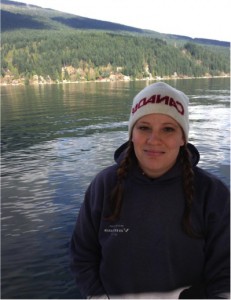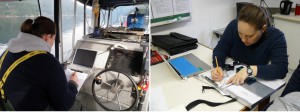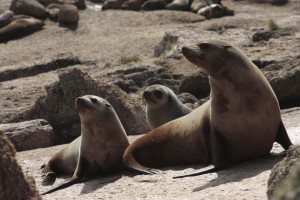 Postdoctoral Research Fellow
Postdoctoral Research FellowInstitute for the Oceans and Fisheries, Faculty of Science at the University of British Columbia
Research Interests: bioenergetics, heart rate, physiology, foraging ecology of marine mammals, biologging, statistical analysis and R coding with a focus on LME, GLMM, GAMM models, and “big data”.
Teaching Interests: My teaching philosophy is grounded in fostering a growth mindset for students to become independent, resilient, life-long learners. I also believe that evidence-based teaching practices with an emphasis on active learning are the most effective (and usually more fun) for students and teachers.

Postdoctoral Research Project: killer whale bioenergetics
This project involves constructing comparative bioenergetic models to predict daily food requirements of southern and northern resident killer whales.
We are able to calculate how much energy a whale is using during different activities by counting how many times they breathe during that activity from drone video data. We coupled drone video data showing breathing rate and behaviour with dataloggers attached to the same whales that measured dive behaviour, duration, and depth. This is important to know how much food they need to consume.
In collaboration with Tess McRae, UBC Master’s student, and colleagues at the Department of Statistics and Hakai Institute, we found that whale spend most of their time making shallow short dives and that respiration rate differs among behaviours of resting, travelling, and foraging.
Watch a cool video of killer whales breathing and find out more here in the recent article published in PLOS ONE, Popular Science, UBC News, and Glacier Media.
Courses taught at UBC
- SCIE 113: First-Year Seminar in Science
- BIOL 501: Quantitative Methods in Ecology and Evolution
- BIOL 121: Genetics, Evolution, Ecology
- BIOL 260:Fundamentals of Physiology
- BIOL 361: Physiology of Sensory, Nervous and Muscular Systems
- BIOL 363: Animal Physiology Laboratory and Lecture (Lab)
- BIOL 418: Evolutionary Ecology
PhD Thesis: Factors influencing foraging success in otariid seals
My PhD thesis examined the factors that influence the foraging efficiency in otariid seals both free-ranging and trained. Three of the research questions I examined are described below.
1.Can head-mounted accelerometers be used to detect successful prey captures in Australian fur seals?
I simultaneously measured 3-dimensional movement on head-mounted accelerometers and recorded video from the animal’s perspective on National Geographic Crittercams. I quantified the prey captures measured on the accelerometers and compared it with the prey captures recorded on the video. By comparing the successful prey captures seen on the video to the prey captures measured on the accelerometer, I determined the accuracy of using accelerometers to detect successful foraging dives.
View video on related research: “Monster Data: unveiling the secret lives of marine mammals”. Have you ever wondered how scientists know where marine mammals go and what they actually do while underwater? Join the Vancouver Aquarium, the University of British Columbia and the Peter Wall Institute for an evening with biologists and statisticians as they reveal secrets contained in monster data now being collected by whales, seals and sea lions equipped with high-tech cameras and micro-computers.
Link to video of public lecture in May 2015:
2.Can dive characteristics be used to predict successful prey captures and forage dives in Australian fur seals?
Dive characteristics (dive duration, dive depth, ascent speed, dive shape) from time-depth recorders (TDRs) are often used to infer measures of foraging success in pinnipeds. However, these inferences have not been directly validated in the field with video, and it remains unclear if this method can be applied to benthic foraging animals with little variation in dive shape, such as the Australian fur seal. I compared the prey capture attempts predicted from a range of dive characteristics to the actual prey capture events observed on National Geographic Crittercam video. This allowed me to assess the accuracy of using TDRs to predict foraging behaviour. Results from this study linking verified foraging dives to common dive characteristics potentially opens the door to decades of historical TDR datasets across several otariid species.
3.Can 3-dimensional movement predict metabolic rate in Steller sea lions diving with a large oxygen debt?
This project done in collaboration with UBC and the Vancouver Aquarium complements the research on free-ranging Australian fur seals by examining the energetic component of foraging efficiency. 3-dimensional movement (ODBA) has been used to predict metabolic rate, but it remains unclear if this relationship holds true when the animals carry a large oxygen debt over several dives in a series.I determined if the relationship between metabolic rate and 3-dimensional movement changed in Steller sea lions diving with a large oxygen debt over long dive durations and several dives in a series.
Using 3-dimensional movement (or overall dynamic body acceleration ODBA) to predict metabolic rate in sea lions is analogous to a person using a pedometer app (that counts your steps) on their smartphone to predict the number of calories burned during exercise.

Collecting and analyzing acceleration data at the Open Water Research Station
Graduate Student Opportunities: I am not accepting graduate students currently.
Publications
- McRae, T.M.,Volpov, B.L., Sidrow,E., Fortune, S.M.E., Auger-Méthé, M.,Heckman,N., Trites, A.W., (2024) Killer whale respiration rates. PLOS ONE: https://doi.org/10.1371/journal.pone.0302758
- Volpov, B. L., Hoskins, A.J.,, Battaile, B., Viviant, M., Wheatley, K.E., Marshall, G.J., Abernathy, K.,Arnould, J.P.Y. (2015) Identification of prey captures in Australian fur seals (Arctocephalus pusillus doriferus) using head-mounted accelerometers: Field validation with animal-borne video cameras. PLOS ONE e0128789
-
Volpov, B. L.,Rosen, D. A.,A. W. Trites, and Arnould, J.P.Y. (2015) Validating the relationship between 3-dimensional body acceleration and oxygen consumption in trained Steller sea lions. Journal of Comparative Physiology B:1-14
- Rosen, D. A.,Volpov, B. L., and A. W. Trites. (2014). Short-term episodes of imposed fasting have a greater effect on young northern fur seals (Callorhinus ursinus) in summer than in winter. Conservation Physiology 2:cou021.
- Rosen, D.A.S., Young, B. L., Trites, A.W. (2012). Rates of maximum food intake in young northern fur seals (Callorhinus ursinus) and the seasonal effects of food intake on body growth. Can. J. Zool., 90:61-91.
- Young, B. L., Rosen, D. A. S., Haulena, M., Hindle, A. G. and Trites, A. W. (2011). Dive behaviour impacts the ability of heart rate to predict oxygen consumption in Steller sea lions (Eumetopias jubatus) foraging at depth. J. Exp. Biol. 214:2267-2275.
- Young, B. L., Rosen, D. A. S., Haulena, M., Hindle, A. G. and Trites, A. W. (2010). Environment and digestion change the ability of heart rate to predict metabolism in resting Steller sea lions (Eumetopias jubatus). J Comp Physiol B, (in press DOI 10.1007/s00360-010-0504-8)Young et al 2010
- Hindle, A. G.,Young, B.L., Rosen, D.A.S, Haulena, M., Trites, A.W. (2010). Dive response differs between shallow-and deep-diving Steller sea lions (Eumetopias jubatus). Journal of Experimental Marine Biology and Ecology 394:141-148.Hindle et al 2010
- Young B.L. (2010). Influence of environment, feeding, and dive activity on the use of heart rate to predict oxygen consumption in resting and diving Steller sea lion (Eumetopia jubatus). Masters Thesis, University of British Columbia, Vancouver.(MSc thesis pdf)
Grants and Fellowships Awarded
- ANZ Trustees Foundation Holsworth Wildlife Research Endowment, 2011-2014
- M.A. Ingram Trust, Ph.D 2011
I am appreciative of the help and support provided by:
 |
 |


